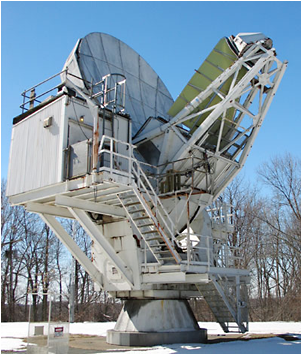 |
 |
 |
 |
 |
 |
 |
 |
 |
 |
|
Research @ KICP
|
Projects Archive: CAPMAP Overview  Cosmic Background Radiations CAPMAP Website CAPMAP is an attempt to measure the polarization anisotropy of the cosmic microwave background (CMB) using the 7m Crawford Hill Telescope in New Jersey, along with intensive instrumentation additions. The Cosmic Microwave Background (CMB), as the relic radiation from the hot, dense phase of the early universe, is an invaluable cosmological probe. In particular, the small variations in the CMB from point to point across the sky encode an immense amount of information regarding the structure and composition of the early universe. Indeed, variations in the intensity, or temperature, of the CMB have now been measured with sufficient accuracy and precision that they place important constraints on cosmological models. However, these temperature anisotropies are not the only structures observable in the CMB. The CMB should also have an anisotropic polarized component, which represents a source of additional cosmological information. Even though there have been several searches for this cosmological polarization in the three decades since Penzias and Wilson (1965) first reported the detection of the ``unpolarized'' microwave background, the polarized component of the CMB has so far eluded detection. This is not that surprising, since the current body of theory strongly predicts that the polarization of the CMB should be an order of magnitude smaller than the temperature anistropies (roughly one part in or about 5 K at most), which is below the detection threshold of all measurements to date. However, with the increasing sensitivity of microwave receivers, the limits on the polarized component of the CMB have steadily improved and the tightest limits are now around 10 uK (Subrahmanyan et. al., 2000; Hedman et.al., 2001; Keating et. al., 2001). Current efforts to detect and measure the cosmological polarization can be divided into two groups. On the one hand, there are experiments which were designed primarily to measure the temperature anistropies, but which have some polarization sensitivity as well. The recent Saskatoon, TOCO and ATCA experiments are in this tradition, as are the ongoing CBI, DASI, BOOMERanG and MAXIPOL projects. On the other hand, there are experiments which were designed exclusively to look for CMB polarization. POLAR, which has produced the strongest limit on CMB polarization yet, falls within this group, along with the ongoing COMPASS and Polatron experiments. The project described here is another of these dedicated polarimeters: the Princeton IQU Experiment or PIQUE (the IQU refers to the Stokes parameters that describe the polarization state of electromagnetic radiation.) CAPMAP Website Talks, Lectures, & Workshops
|





 Overview
Overview